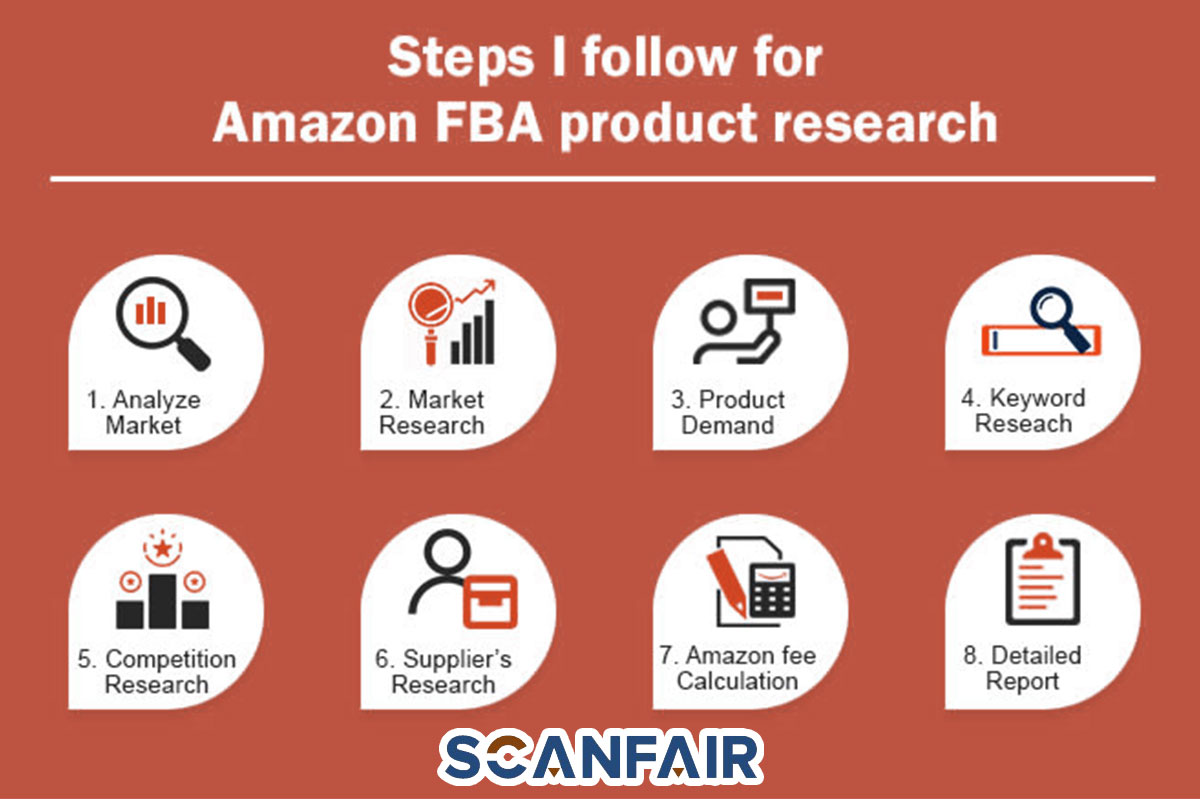Amazon is a colossus in the vast expanse of e-commerce, commanding a substantial share of the online retail market. The road to success in this highly competitive arena goes beyond mere product listings; it hinges on a strategic approach to product sourcing. To flourish on this platform, one must deploy astute product-sourcing strategies that can help maintain a competitive edge. In this extensive guide, we embark on a comprehensive journey into Amazon product sourcing strategies, offering invaluable insights, tips, and tactics to navigate this ever-evolving marketplace adeptly. The purpose of this Scan fair article is to teach product sourcing strategies for Amazon
The Imperative of Product Sourcing on Amazon
Before we delve into the intricacies of product sourcing strategies, let us first appreciate why product sourcing is a cornerstone of success on Amazon.
The Significance of Product Sourcing
Amazon’s sprawling product catalog spans everything from everyday essentials to rare, niche items. As an Amazon seller, the challenge is to pinpoint products that align with market demand and offer a competitive advantage while ensuring sustained profitability. This is where the art of effective product sourcing comes into play.
Aligning with Market Demand
Thriving on Amazon necessitates identifying products actively sought after by customers. Achieving this involves conducting meticulous market research to unearth trends, gauge demand, and identify potential niches. Leveraging tools such as Google Trends, Amazon’s Best Sellers list, and keyword research can help uncover popular product categories.
Competitive Advantage
Product sourcing is not merely about finding any product; it’s about finding the right products. It’s about differentiating your offerings from competitors. Look for unique products, avenues for quality enhancement, or bundling opportunities that confer a competitive edge.
Profitability and Sustainability
Sourcing products at the right price point is imperative to maintain robust profit margins. It’s not just about the initial purchase cost; it involves factoring in Amazon’s fees, shipping expenses, and potential storage charges. Sustainable profitability is the bedrock of the longevity of your Amazon enterprise.
Diverse Avenues of Amazon Product Sourcing Strategies
Now that we have grasped the paramount importance of product sourcing let us embark on a journey to explore the multifarious strategies that Amazon sellers employ to source products effectively.
Retail Arbitrage
Retail arbitrage entails procuring products from physical retail stores, often at discounted prices, and reselling them on Amazon at a profit. This method relies on identifying disparities in prices between brick-and-mortar retail establishments and Amazon’s digital marketplace.
Online Arbitrage
Online arbitrage mirrors the concept of retail arbitrage but involves the procurement of products from online retailers. This approach frequently leverages specialized software to pinpoint profitable opportunities by capitalizing on price variations.
Wholesale Sourcing
Wholesale sourcing involves bulk purchases of products directly from manufacturers or authorized distributors at discounted rates. This strategy necessitates cultivating robust relationships with suppliers and adept negotiation skills.
Private Labeling
Private labeling revolves around the procurement of generic products that are subsequently branded under your own label. This approach affords the opportunity to create distinctive product listings and cultivate a unique brand identity. It is a long-term strategy that demands a dedicated focus on branding and marketing efforts.
Advanced Product Sourcing Techniques
As one progresses along the path of an Amazon seller, it becomes imperative to embrace advanced product sourcing techniques to not only remain competitive but also to maximize profits.
Product Bundling
Product bundling entails the creation of unique product packages by amalgamating complementary items. This strategy can elevate the perceived value of your offerings and reduce competition, as customers are unable to readily find identical bundled products elsewhere.
International Sourcing
Expanding the horizons of your sourcing efforts beyond your local market can open up exciting vistas of opportunity. Consider sourcing products internationally, albeit with caution regarding import regulations, shipping costs, and potential language barriers.
Amazon FBA (Fulfillment by Amazon)
Leveraging Amazon’s FBA program can significantly streamline your product sourcing and fulfillment processes. With FBA, Amazon assumes responsibility for storing, packing, and shipping your products. This allows you to focus on sourcing and marketing and makes your products eligible for Amazon Prime, thereby enhancing their visibility.
Diversifying Suppliers
Placing undue reliance on a single supplier can entail risks. Diversifying your supplier base is prudent, as it helps mitigate the impact of potential disruptions. Exploring options for backup suppliers and nurturing strong relationships with multiple sources can enhance your supply chain resilience.
Data-Driven Sourcing
Harness the power of data analytics and specialized software tools to make informed sourcing decisions. Monitor sales trends, scrutinize customer reviews, and keep an eye on competitors’ pricing to proactively adjust your sourcing strategy.
Navigating Amazon’s Sourcing Policies
To thrive on Amazon, strict adherence to the platform’s sourcing policies and guidelines is non-negotiable. Amazon has put these rules in place to ensure a safe and trustworthy shopping experience for customers.
Authenticity and Quality
In all your sourcing endeavors, it is paramount to source only authentic and high-quality products. Dealing with counterfeit or subpar items can result in account suspension or even permanent bans.
Restricted Categories
Stay vigilant regarding restricted product categories. Some items necessitate prior approval from Amazon before they can be listed for sale. Failure to comply with these restrictions can lead to account complications.
Intellectual Property
Respect intellectual property rights with the utmost diligence. Avoid selling products that infringe on copyrights, trademarks, or patents. Amazon boasts robust mechanisms to protect the rights of intellectual property owners.
Compliance with Local Laws
Understand and rigorously adhere to local and international laws and regulations governing the sourcing and sale of products on Amazon. Failure to do so can result in legal repercussions.
Optimizing Your Amazon Product Listings
Effective product sourcing represents only one facet of the equation. To truly maximize your success on Amazon, you must optimize your product listings to captivate and convert customers.
Keyword Research
Conduct comprehensive keyword research to discern the terms and phrases that customers commonly use when searching for products in your category. Incorporate these keywords judiciously into your product titles, descriptions, and backend keywords to enhance discoverability.
High-Quality Images
Utilize high-resolution images that effectively showcase your products from various angles. Clear, professional images inspire trust and enable customers to make informed purchasing decisions.
Compelling Product Descriptions
Craft compelling and informative product descriptions that eloquently convey the key features and benefits of your products. Address potential customer queries and objections proactively.
Competitive Pricing
Frequently review and adjust your pricing strategy to remain competitive. Take into account factors such as shipping costs, Amazon fees, and your desired profit margin to strike a pricing balance that is attractive to customers while ensuring profitability.
Customer Reviews and Feedback
Actively encourage satisfied customers to leave positive reviews. It’s equally crucial to address any negative feedback promptly and constructively. This demonstrates your unwavering commitment to customer satisfaction and helps build trust with potential buyers.
A+ Content and Enhanced Brand Content
Where eligibility permits, make the most of Amazon’s A+ Content and Enhanced Brand Content features. These tools empower you to create visually captivating, multimedia-rich product listings, which can significantly boost conversion rates and elevate your brand’s image.
Pay-Per-Click Advertising (PPC)
Leverage Amazon’s Pay-Per-Click (PPC) advertising platform to enhance the visibility of your products. However, it’s essential to diligently manage your PPC campaigns to optimize your advertising spend and target relevant keywords effectively.
Scaling Your Amazon Business
Successful product sourcing can pave the path to substantial growth in your Amazon venture. Here are some strategies to help you scale your operations effectively.
Inventory Management
Maintain a balanced inventory level that can meet demand without overstocking or facing the challenge of running out of stock. Utilize specialized software tools to track inventory turnover and establish reorder points.
Expand Your Product Catalog
Gradually diversify your product offerings to broaden your revenue streams. However, ensure that new products align with your niche and meticulously researched market.
Outsourcing
Consider outsourcing various tasks such as customer service, order fulfillment, and even product research. Doing so can free up your time to focus on critical strategic decisions that can drive growth.
International Expansion
Explore opportunities to sell on Amazon’s international marketplaces. This expansion can significantly increase your customer base and overall revenue. However, it comes with its unique set of challenges, including currency conversion, shipping logistics, and compliance with international regulations.
Brand Building
Invest in establishing a robust brand presence on Amazon. This involves creating a memorable brand logo, utilizing Enhanced Brand Content, and providing exceptional customer service. A strong brand can differentiate you from competitors and build trust among customers.
Challenges and Pitfalls in Amazon Product Sourcing
While Amazon offers immense opportunities, it is essential to recognize and understand the unique challenges it presents. Mastery of these challenges is paramount to navigating the platform successfully.
Competition
The Amazon marketplace is intensely competitive. To thrive, you must continuously innovate and adapt your sourcing strategies to stay ahead of competitors. Keep a vigilant eye on market trends and customer preferences.
Amazon Fees
Amazon imposes various fees on sellers, including referral fees, fulfillment fees, and storage fees. It is crucial to factor these fees into your pricing and profit calculations to ensure that your business remains profitable.
Changing Policies
Amazon frequently updates its policies and algorithms. Staying informed about these changes and adapting your business practices accordingly is essential to avoid potential account issues or penalties.
Counterfeit Products
Sourcing and selling counterfeit products can have severe consequences, including account suspension and legal actions. Vigilance in sourcing authentic products is imperative.
Monitoring and Adapting Your Sourcing Strategy
The e-commerce landscape is dynamic, and your sourcing strategy must evolve with it. Continuous monitoring of your sales, customer feedback, and market trends is critical for making informed adjustments.
Key Performance Indicators (KPIs)
Track key performance indicators (KPIs) such as sales velocity, conversion rates, and return on investment (ROI) to assess the effectiveness of your sourcing strategy. These metrics can provide valuable insights into areas that require improvement.
Customer Feedback
Listen attentively to customer feedback to identify areas for enhancement. Address negative feedback promptly and use it as an opportunity to improve your products and services.
Market Trends
Stay updated on industry and market trends. Embrace new sourcing opportunities that align with evolving consumer preferences and needs. Being proactive in adapting to market changes can give you a competitive advantage.
Success Stories
Learning from the experiences of successful Amazon sellers who have mastered the art of product sourcing can provide valuable insights and inspiration. These stories serve as real-world examples of the strategies and tactics that lead to success on the platform.
Conclusion
In the fiercely competitive realm of Amazon, effective product sourcing is the bedrock of success. It is a dynamic process that demands continual adaptation and innovation. By comprehending the various sourcing strategies, adhering to Amazon’s policies, optimizing your product listings, and maintaining vigilance, you can build a thriving Amazon business.
Remember, success on Amazon is not achieved overnight. It requires dedication, patience, and an unwavering commitment to continuous improvement. As you navigate the complexities of Amazon product sourcing, keep learning, remain adaptable, and prioritize delivering value to your customers. With the right strategies and a relentless pursuit of excellence, you can conquer the Amazon marketplace and achieve your e-commerce goals. Wishing you the best of luck on your Amazon journey!


